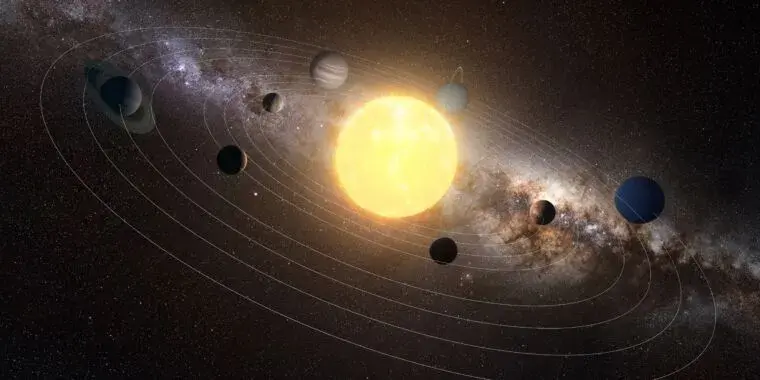The post demonstrates how infeasible it is to travel to a location outside our solar system anytime in the next several generations.
What are some things you would like to see humanity do within our solar system within the next century? When do you think it is feasible to achieve that goal?

I don’t know if it will happen in the next century, but we definitely should focus on moon and Mars colonies before thinking about leaving the solar system. I’m 48 and would love if we had a moon colony in my lifetime. At the very least some station where astronauts have an extended stay like they do on ISS.

@saba @Recant We’re definitely not going to have a moon colony in our lifetime, and a manned mars mission would only be a disaster.
The reason we haven’t really gone back to the moon and don’t have a colony there is because it’s much more expensive to access and offers no real benefit over space stations. It’s perk is low gravity instead of microgravity, but it trades off in massively increased fuel and time costs as well as the inability to “dodge” hazards. The moon has no special resources, no capacity for terraforming, and if we were wanting to build enclosed habitats we could do that more easily in a space station.
Mars is kinda worse because as far as I can tell we’re finding problems faster than we’re finding solutions. My favorite recent example of this is that we discovered anyone we sent would go blind before reaching the planet (microgravity destroys your vision over time, it took us forever to find out because the astronauts were hiding it so they wouldn’t be disqualified from future flights).

Why does microgravity cause blindness?

We don’t know yet https://youtube.com/watch?v=zXq5Uu1rRtA

I’m going off memory, but I’m pretty sure I read somewhere that the lack of gravity pushes all the blood in your body up to your head. On earth, your body has to fight gravity to get blood to your brain, so it evolved to squeeze blood out of your legs and lower body. In zero-g, the resistance is gone, but our bodies arent going to adapt so easily, so the blood is now being squeezed upward creating extra blood pressure in your head. I think i remember reading that some of that extra pressure concentrates right behind the eyes, which you can imagine is not great for them over time.
The most livable place outside of the Earth is in the upper atmosphere of Venus. It’s way closer to the Earth. And air pirates would sail through clouds of sulfuric acid on their steampunk zeppelins.

49 here, and I was always hopeful that I’d see us make it to another solar system in my lifetime. Another planet in our solar system would still be great, though!

People in general have a hard time conceptualizing how large and empty space is. With our current propulsion technology it will take longer than the human lifespan, barring any absolutely groundbreaking cryonics developments, to reach even the Oort cloud of our own solar system.
I think in the next century, a reasonable goal is to have small sparsely manned mining outpost settlements on Mars. There’s enough financial incentive where I could see a future where it happens.
- Morcyphr ( @Morcyphr@lemmy.one ) English6•2 years ago
This is probably the correct answer. I’m a fairly smart guy but the enormity of space is astounding. We aren’t going far anytime in the near future. Probably we’ll kill each other first. Manned Mars is even a stretch even, imo.

Ion drives. A little acceleration over a long time can get you going quite fast. I doubt chemical rockets will be used much except actually getting off the planet soon.

@shortwavesurfer @InquisitiveApathy ion drives really don’t solve any of these problems.
Orbital dynamics are *weird* and “more speed” isn’t a solution. With orbital dynamics your relative position and speed are directly related, so moving faster basically means changing direction. Once you’re in microgravity thrust power is more about how quickly you can steer and fuel quantity is how many maneuvers you can do. Ion drives can do a lot of maneuvers, but every maneuver is very slow (which also makes them more complicated because you need to account for the changes that happen over the course of the maneuver).
We don’t travel to orbital bodies in a straight line because it goes beyond an absurd quantity of fuel to do so (ion drives don’t even scratch the surface of the amount needed, let alone the complexity they add due to slow acceleration).
Right now we don’t have much to improve the speed of getting places and not much on the horizon there either, so we’re focusing on questions like how to survive getting there.

I had to read this a couple times to make sure i got it. Thanks for that. As far as i understand it at least orbits and courses are much easier with chemical fuel because its point and thrust and all over in a matter of a couple hours. Your fuel is mostly expended and you are on the correct track with very small adjustments possibly required. An ion drive while slow is an exponential curve because its speeding up on top of the speed it already has. So instead of going from 0, to 1, to 2, to 3, to 4, to 5 it would go from 0, to 1, to 2, to 4, to 16, to 256. If i am understanding correctly this would far outsrip a point and thrust craft quickly. A probe to mars takes 9 months during the transfer window but i have heard estimates of 3 months for an ion drive craft

@shortwavesurfer The propulsion is absolutely linear, the perk of an ion drive is that it’s mostly electrical with minimal fuel consumption.
It’s also something we’re already using, the first one actually launched was in 1964, though for some reason we never stopped hyping it.
An ion engine would absolutely make the trip take *longer* as you’d have to wait for better transfer windows (9 months is the timeframe *after* we wait for a good transfer window), we’d have to wait even longer for one with an ion drive and it absolutely wouldn’t be a shorter window.

For in-system travel, we have to invest in space infrastructure, same as we did for the Oregon trail -> highways, the earliest sailing ships -> hydrofoil ships and aircraft carriers, and from covered wagons to cargo trains.
Skyhooks are a system of locomotion we could already do today, and save tons of expense on fuel and lift capacity, it’s just staggeringly expensive to do. We would need to redesign our spacecraft and building the first skyhooks would be a joint nation-state endeavor.
Interesting high level overview on them here. https://youtu.be/dqwpQarrDwk
Pretty decent pre generation-ship technology.


